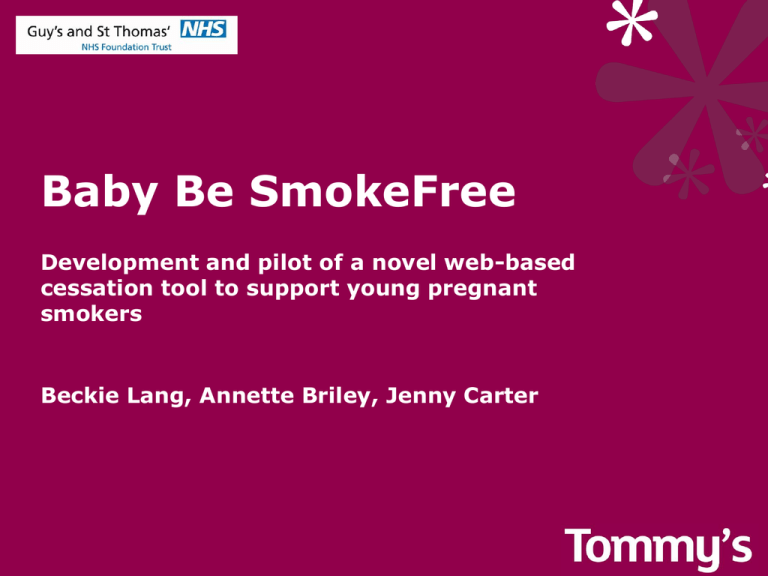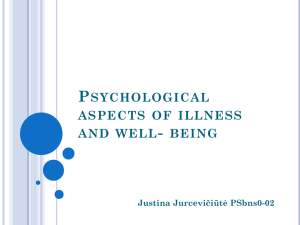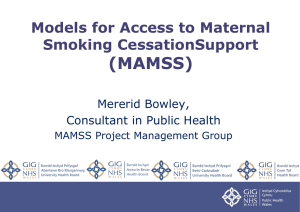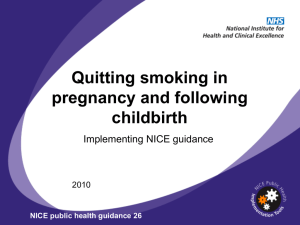to the presentation (Powerpoint or viewer needed)
advertisement

Baby Be SmokeFree Development and pilot of a novel web-based cessation tool to support young pregnant smokers Beckie Lang, Annette Briley, Jenny Carter At Tommy’s we believe that every pregnancy deserves a happy ending. Our Mission is to halve the number of babies that die during pregnancy or birth by 2030 We exist to save babies’ lives by funding research and providing information on the causes and prevention of miscarriage, premature birth and stillbirth. Smoking in pregnancy (at the time of the study) • 17% of women in the UK smoke throughout their pregnancy (Bolling 2005) • Teenage mothers are more likely to smoke during pregnancy • 45% of teenagers compared to 9% of over 30’s (Stats’on Smoking 2008) • Proportion of mothers who smoke during pregnancy fell between 2000-2005 • Except in under 20’s – in which smoking increased by 6% (Stats’on Smoking 2008) • Pregnant women under the age of 20 were therefore the target segment for this project. Referral – the key issues in literature • Midwives are not always referring because: – Midwife client relationship (Aveyard et al 2004) – Clients have severe social health problems (Lowry 2003, MacAskill 2008) – Time (Condliffe et al 2004) – Lack of enthusiasm (Lowry 2003) • Pregnant women do not always admit to smoking (ASH 2008, McNeil 2001) – Guilt and worries about health of the child (Todd 2003) – Being afraid of failure (Usher 2005) – Worries about being nagged (Lowry 2003) Aveyard, P. Lawrence, T. Croghan, E. Evans (2004) Is advice to stop smoking from a midwife stressful for pregnant women who smoke? Data from a randomised controlled trial. Preventative Medicine Vol 40 Lowry R, Hardy, S. Jordan, C. Wayman G. (2003) Using social marketing to increase recruitment of pregnant smokers to smoking cessation service: a success story MacAskill, S. Bauld, L, Tappin, D. Eadie, D. (2008) Smoking cessation support in pregnancy in Scotland. A report for the Department of Health, Scotland. ASH (2008) Department of Health Consultation of the Future of Tobacco Control. Submission from Action on Smoking and Health. McNeill (2001) Saliva cotinine as indicator of cigarette smoking in pregnant women. Addiction 96: 1001-6 Condliffe, L. McEwen, A.; West, R.(2004). The attitudes of maternity staff to, and smoking cessation interventions with, childbearing women in London. Midwifery,. Sep. 21(3) p233-40 Todd, AM. (2003) Barriers to smoking cessation in pregnancy: a qualitative study. British Journal of Community Nursing. Feb 8 (2) Usher, M. Etter, JF. West, R. (2005) Perceived barriers and benefits o attending a stop smoking course during pregnancy . Patient education and counseling. June Vol 61. 3 Talking about cessation and referral with clients The views of 60 Teenage Pregnancy Midwives Referring to smoking LSSS For every 10 of my clients who smoke I would expect to refer the following number to LSSS at booking 10 25.9% 9 1.7% 8 5.2% 7 15.5% 6 6.9% 5 15.5% 4 8.6% 3 10.3% 2 1.7% 1 8.6% 0 5 10 15 20 Percentage of midwives referring 25 30 Enabling factors I feel confident that I can describe the benefits of quitting to my clients 94% agree or strongly agree Referring a client to LSSS helps her to have the best chance of quitting 81% agree or strongly agree I think that LSSS will offer a service that meet my teenage clients’ need 56% agree or strongly agree I think that LSSS staff will be friendly and supportive towards my clients 90% agree or strongly agree Potential barriers to referral Pregnant teenagers sometimes have more serious problems to deal with • 64% agree or strongly agree (Majority) Midwives are sometimes short of time at booking appointments • 58% agree or strongly agree (Majority) Midwives are sometimes concerned about damaging their relationship with their clients • 38% agree or strongly disagree (Significant minority) • 46% disagree or strongly disagree (Majority) Midwives are sometimes concerned they will make their clients feel guilty about smoking • 40% agree or strongly agree (Significant minority) • 42% disagree or strongly disagree (Majority) Smoking cessation and LSSS Tommy’s qualitative research with 32 pregnant teenagers who smoke or have quit during pregnancy Smokers and motivated quitters included Based on the Theory of Planned Behaviour • Knowledge of: – effects of smoking on the fetus – help available to quit • Attitudes towards: – smoking in pregnancy – quitting • Beliefs about: – LSSS – NHS Pregnancy Smoking Helpline • People who influence attitudes and beliefs • Alternative message framing Barriers to engaging with LSSS • Talking to LSSS seen as a clear commitment to quitting – Some women did not feel ready for that • Want to quit alone – through their own will power – want to take control/ make their own choices “I’d rather do it on my own. I think if people try to make you do something then it just doesn’t work.” Pregnant, smoker • Not convinced that LSSS can help them “I really don’t see how someone can stop me from smoking, so that stops me from going to see someone.” Recent mum and motivated quitter “I wouldn't want to be around a load of other people speaking about myself when I don't know them. I just see it as people who do drugs and stuff who go to that type of thing.” Recent mum and motivated quitter • Some negative perceptions of LSSS “Pretty bossy I reckon, saying you can’t do this or that and all things like that.” Recent mum and smoker Message testing • Focusing on consequences of smoking during pregnancy • Relevant and accessible to young women • Tone: factual not alarmist • Information delivered sequentially • Range of messaging about the risks of smoking – Increased risk premature birth – Impact of carbon monoxide and other toxins on baby’s heart rate – Baby may become addicted to nicotine Increased risk of premature birth • Babies of smokers are more likely to be born too soon • Babies that are born too soon are more likely to suffer from severe breathing problems, stunted growth, diabetes and heart disease • Babies that are born too soon are more likely to have to stay in hospital after the mother goes home and may need help breathing and controlling their body temperature “I knew that that happened to premature babies, but I didn’t realise it was anything to do with smoking.” Pregnant and smoking “Yeah it’s scary. You could go home without your baby so it’ll need looking after because of you.” Recent parent and motivated quitter Impact of nicotine on baby’s heart • Every time you take a drag on a fag 4,000 chemicals enter your body • Within two and a half minutes of starting a cigarette these chemicals make your heart pump faster • Five minutes later your baby’s heart does the same “That’s a lot of chemicals. Imagine that all going into your child and it’s only small.” Pregnant and smoking “For the baby it’s not good is it, not really….. It’s not just about you any more is it?” Smoking and pregnant Summary • Teenagers know that smoking in pregnancy is dangerous but they do not understand the specific risks • Midwives are talking to teenagers about the dangers of smoking in pregnancy and the importance of stopping smoking • Midwives are not always referring their smoking clients to LSSS • Teenagers believe that: – They could quit on their own – LSSS could not tell them anything new – LSSS could not provide the kind of support that would help them to quit – LSSS are judgemental and will give them a ‘hard time’ • Teenagers a very aware of the social stigma of smoking during pregnancy and feel guilty about their smoking • Teenagers do not always admit to smoking when asked Baby Be SmokeFree Self-Referral Tool www.tommysbabybe.org.uk Insight to Intervention Insight Research •Prematurity impacts •4000 chemicals •Stigma •‘Will LSSS judge me?’ •Problems of quitting alone Main Video Clip •Type of service •‘Its an addiction, so how can LSSS help’? ‘Are LSSS supportive?’ •Strategies used •NRT •‘What if I fail?’ Video Interview with LSSS advisor •A personal service •Non-judgemental approach •Call back service to minimise cost Video interview with Helpline •Not wanting to admit to smoking •Stigma and worry about being judged Self-referral option Direct impact of 4000 chemicals in each cigarette on the baby Flash animation progress of smoke through mother to baby Presentation title in footer 13 April 2015 20 21 Piloting • Inner city tertiary referral centre in area with high teen pregnancy • Routine 10-14 week ultrasound appointment (trigger point?) • Women aged between 16-19y invited to view BBSF by research midwife Participants • 94 women identified within study period • 74 approached and 36 agreed to participate • 16 of these were smokers Women’s views of BBSF Presentation title in footer 13 April 2015 Number of women Women’s behavioural intention following viewing BBSF 23 Additional findings • N=15 (9 smokers, 6 quitters) Aged 16-19y • Seven individual interviews, four paired interviews plus follow-up call. • BBSF was successful in: – improving the target audience’s attitudes, beliefs, knowledge and understanding of the negative impacts of smoking in pregnancy. – Accurately representing the target group (women related to those in the videos) • There were mixed results: – in behavioural intentions. After viewing BBSF most smokers reported a much higher motivation to quit. – In facilitating a quit attempt with LSSS. Family Nurse Partnership feedback • n-= 23 • Clips of other young women talking about cessation most appealing (70%) • Cost calculator most helpful (65%) • 35% of nurses were showing the opening film with women, 48% some of the time. • Opening film usually lead to further exploration of the site (90%) • Requests for the site to be available as a mobile app and a website FNP thoughts on effectiveness of BBSF Adjustments to BBSF and Next steps •BBSF chat to an advisor removed and support information provided instead. •Qualitative research with young women by UCL to understand what would make them quit to facilitate further development of the BBSF suite of resources. •Exploration of a teen specific strand of the LSSS – 3-5 pilot sites nationally for testing the concept. Tommy’s Health Campaigns For further information on the Baby Be SmokeFree campaign please contact: Dr Beckie Lang Health Campaigns Manager 07887617195/ blang@tommys.org





